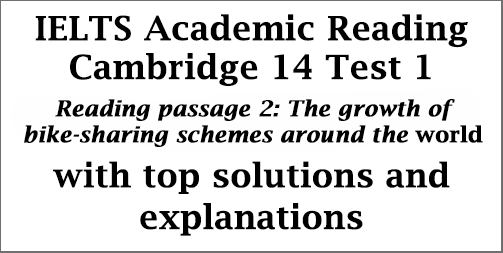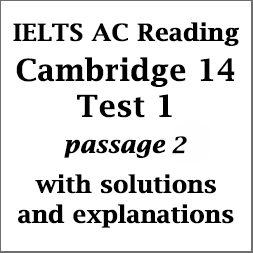IELTS Academic Reading: Cambridge 14, Reading Test 1: Passage 2; The growth of bike-sharing schemes around the world; with top solutions and detailed explanations
This IELTS Reading post focuses on all the solutions for the new IELTS Cambridge 14 Reading Test 1 passage 2 which is entitled ‘The growth of bike-sharing schemes around the world‘. This is an aimed post for candidates who have major problems in finding Reading Answers. This post can guide you the best to comprehend every Reading answer easily. Finding IELTS Reading answers is a gradual process and I hope this post can help you in this respect.

IELTS Cambridge 14 Test 1: AC Reading Module
Reading Passage 2:
The headline of the passage: The growth of bike-sharing schemes around the world
Questions 14-18: Identifying information
[This question asks you to find information from the passage and write the number of the paragraph (A, B, C or D … .. ) in the answer sheet. Now, if the question is given in the very first part of the question set, I’d request you not to answer them. It’s mainly because this question will not follow any sequence, and so it will surely kill your time. Rather, you should answer all the other questions first. For this passage, first answer questions 4- 13. After finishing with these questions, come to questions 1-3. And just like the List of Headings, only read the first two lines or the last two lines of the expected paragraph initially. If you find the answers, you need not read the middle part. If you don’t find answers yet, you can skim the middle part of the paragraph. Keywords will be a useful matter here.]
Question 14: a description of how people misused a bike-sharing scheme
Keywords for this question: misused, bike-sharing
In paragraph E we find a reference to some problems the designers were facing in the project. Line line 4, the writer says, “The system, however, was prone to vandalism and theft.” Take a look at the statement made by Theo Molenaar too, “ ‘After every weekend there would always be a couple of bikes missing,’ Molenaar says, ‘I really have no idea what people did with them, . .. .”
So, the lines reveal the fact that people were misusing the scheme
So, the answer is: E
Question 15: an explanation of why a proposed bike-sharing scheme was turned down
Keywords for this question: proposed bike-sharing scheme, turned down
In lines 6-7 of paragraph C, the author says, “. . .. Nevertheless, the council unanimously rejected the plan, ‘They said that the bicycle belongs to the past. They saw a glorious future for the car,’. … .”
Here, rejected = was turned down,
So, the answer is: C
Question 16: a reference to a person being unable to profit from their work
Keywords for this question: person being unable, profit
Take a look at the very last line of paragraph F. “… But financially I didn’t really benefit from it, because I never filed for a patent.”
Here, financially I didn’t really benefit from it = unable to profit,
So, the answer is: F
Question 17: an explanation of the potential savings a bike-sharing scheme would bring
Keywords for this question: potential savings
In paragraph C, Schimmelpennink explained his idea to the city council. Take a close look at his explanation, “ . .. . It turned out that a white bicycle – per person, per kilometre – would cost the municipality only 10% of what it contributed to public transport per person, per kilometre.’. .. .”
Here, would cost the municipality only 10% = potential savings,
So, the answer is: C
Question 18: a reference to the problems a bike-sharing scheme was intended to solve
Keywords for this question: problems, intended to solve
In paragraph A, scan lines 3-5, “ . . .They believed the scheme, which was known as the Witte Fietsenplan, was an answer to the perceived threats of air pollution and consumerism.”
Here, was an answer to the perceived threats of air pollution and consumerism = the problems . . .. intended to solve
So, the answer is: A
Questions 19-22 (Multiple choice questions – choosing two from five options)
[Generally, in multiple choice questions, candidates have to choose one answer from three or four options. However, in this type of MCQ, candidates have to choose two answers from five / six options. So, the best tip to find out the answer is to remember that the keywords/clues will be found in two cases/ places. Candidates need to be aware of this fact.]
Questions 19 and 20: Which TWO of the following statements are made in the text about the Amsterdam bike-sharing scheme of 1999?
Keywords for this question: Amsterdam bike-sharing scheme of 1999
In paragraph D, look at lines 7-9, where the writer mentions people’s attitudes about the environment. “ ‘Times had changed,” he recalls. ‘People had become more environmentally conscious, and the Danish experiment had proved that bike-sharing was a real possibility. A new Witte Fietsenplan was launched in 1999 in Amsterdam.” So, this means the Amsterdam bike-sharing scheme of 1999 started (launched) because people’s attitude towards the environment was positive. (Answer: D)
Again, the reference to the Amsterdam bike-sharing scheme of 1999 is in paragraph D. In the same paragraph we find that the Dutch Bank Postbank developed a chip card for the project. But in the next paragraph (paragraph E) the writer says in lines 7-8 , “. . But the biggest blow came when Postbank decided to abolish the chip card, because it wasn’t profitable.. .. . .” This means the partner (Postbank withdrew its support for the scheme). (Answer: B)
So, the answers are (in any order):
B (It failed when a partner in the scheme withdraw support.)
D (It was made possible by a change in people’s attitudes.)
Questions 21 and 22: Which TWO of the following statements are made in the text about Amsterdam today?
Keywords for this question: Amsterdam today
The answer lies in paragraph G because the paragraph starts with “In Amsterdam today.. ..”.
First, take a look at lines 2-3, “. . . it is regarded as one of the two most cycle-friendly capitals in the world – … .” (Answer E)
Again, look at lines 6-7, “.. . People who travel on the underground don’t carry their bikes around. But often they need additional transport to reach their final destination.” The lines clearly explain that a bike-sharing scheme is very important for people who use underground tubes, because they need additional transport (bikes) to get to their expected destination. (Answer D)
So, the answers are (in any order):
D (A bike-sharing scheme would benefit residents who use public transport.)
E (The city has a reputation as a place that welcomes cyclists.)
Question 23-26: (Completing summary with ONE WORD ONLY):
[In this type of question, candidates are asked to ONE WORD ONLY to complete a summary on the given topic. For this type of question, first, skim the passage to find the keywords in the paragraph concerned with the answer, and then scan to find the exact word/words.]
Title of the summary: The first urban bike-sharing scheme
Question 23: The first bike-sharing scheme was the idea of the Dutch group Provo. The people who belonged to this group were ______________.
Keywords for this answer: idea, Dutch group Provo, people, belonged to this group,
The answer is in the second and third lines of paragraph A. “.. .Provo, the organisation that came up with the idea, was a group of Dutch activists who wanted to change society.” .
So, the answer is: activists
Question 24: They were concerned about damage to the environment and about ___________, and believed that the bike-sharing scheme would draw attention to these issues.
Keywords for this answer: concerned about, damage to the environment,
Lines 3-5 of paragraph A give us the answer. “…They believed the scheme, which . .. . .. . ., was an answer to the perceived threats of air pollution and consumerism.”
Here, threats of air pollution = damage to the environment
So, the answer is: consumerism
Question 25: As well as painting some bikes white, they handed out __________ that condemned the use of cars.
Keywords for this answer: painting, white, condemned, use of cars
The answer is in lines 5-7, “… . . In the centre of Amsterdam, they painted a small number of used bikes white. They also distributed leaflets describing the dangers of cars . . .. .. ..”
Here, distributed = handed out, describing the dangers of cars = condemned the use of cars
So, the answer is: leaflets
Question 26: However, the scheme was not a great success; almost as quickly as Provo left the bikes around the city, the __________ took them away. According to …….. . . .. . .. .
Keywords for this answer: not a great success, Provo left the bikes around the city, took them away
The answer is in paragraph B, lines 4-6, “. . .. The police were opposed to Provo’s initiatives and almost as soon as soon as the white bikes were distributed around the city, they removed them.”
Here, left the bikes around the city = the white bikes were distributed around the city, took them away = removed them,
So, the answer is: police
Click here for solutions to Cambridge 14 Test 1 Reading passage 1
Click here for solutions to Cambridge 14 Test 1 Reading passage 3




Thank you very much for the helping, it is understandable for me with your example
Thanks for your explanation of Cambridge 14 test 1. It was very helpful with my practice sessio. Please upload rest of 3 test explanatio.
A bundle of thanks for Cambridge 14 reading test 1 explanation, it was very helpful with my preparatio, now I need to rest of 3 reading test explanation.
I need Cambridge ielts 14 test 3 and 4 reading answer. Please it’s urgent
Dear Rina, I’m working on it. But I can’t make haste. It will take some time.
Hi there,
Thanks for your post. Sometimes it seems that questions have 2 answers. How can we be sure which one is correct for example for question 15, there is also something on paragraph G which says everyone has a bike, why can’t it be the answer?
Also for question 16, on paragraph E it also talks about the fact that the system was not profitable.
I would appriciate it if you would answer my question. Thanks.
Dear Hossein,
I got your email regarding the question. I gave an explanation in a reply mail. Hope that helps you.
I think you need to understand the KEYWORDS better. Thus, you cannot get confused with two answers.
Thank you for the helping in understanding the IELTS reading section. 🙂 Can you help me in understanding couple questions?
1. Why in in 19th question answer cannot be A which states that it was initially opposed by a government department (it was shown in paragraph B)?
2. And also I am interested in the 16th question where the answer E also suits (“it wasn’t profitable” even if it refers to the chip card, we can conclude that the whole project wasn’t profitable, isn’t it). Thanks in advance.
Thank you for posting the solutions.
Hi,
In the questions 21 and 22, why is one of the answers ‘D’? Because in the text has been talked about “people who travel …. final destination”. It means they cannot use this bike-sharing scheme because of travelling on the underground.
IELTS DEAL IS A GREAT BLESSING FOR ME UNDOUBTEDLY HOWEVER, SIR, MAXIMUM THE TIME FACE PROBLEMS ENTERING THE WEBSITE, IT’S SHOWING “ERROR”.
It’s been fixed, I think.